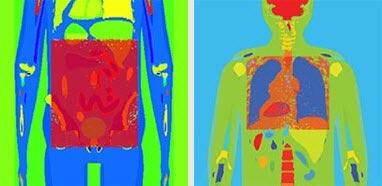Diagnostic Radiation Dosimetry
To support epidemiological studies of medical radiation and cancer risk, DCEG investigators in the Radiation Epidemiology Branch are developing more accurate methods to estimate radiation doses from diagnostic examinations such as radiography and fluoroscopy. As part of that effort, they are developing a new dose calculator, titled the National Cancer Institute dosimetry system for Radiography and Fluoroscopy (NCIRF). The NCIRF is designed to calculate radiation doses more accurately using a new streamlined Monte Carlo transport code combined with a series of computational human phantoms and a graphical user interface.
Simulated radiation doses produced by the system are being validated using physical human phantoms in combination with a radiation dosimeter system.
The NCIRF's design addresses limitations in the PCXMC™, an older radiographic dose calculator that was used to derive organ doses for specific types of x-ray examinations using estimates of entrance skin dose described in historical literature. Radiographic fields and x-ray technical parameters for the PCXMC™ were based on information from a well-known series of radiographic imaging handbooks. This dosimetry approach was previously used to estimate individual medical doses for the U.S. Radiologic Technologists cohort. The NCIRF method is currently being used to update the organ dosimetry.
For more information, contact Dr. Choonsik Lee.
